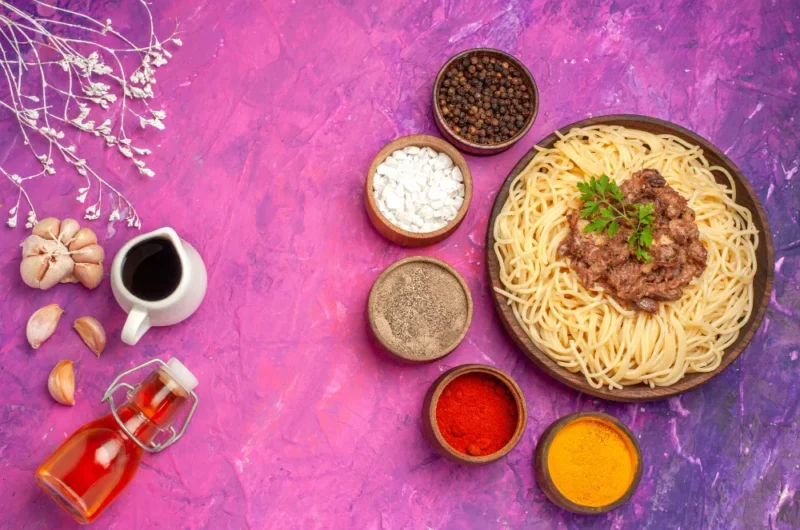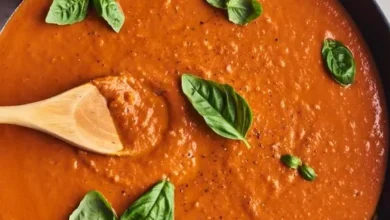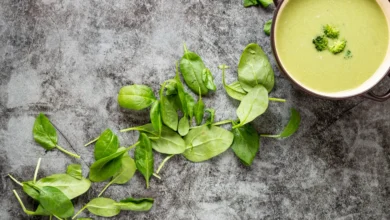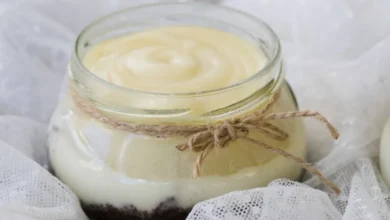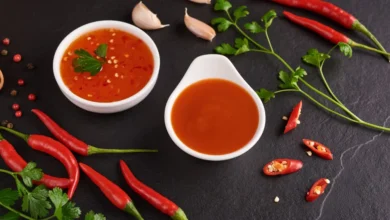Rosy Radiance: Pink Sauce For Pasta

For an easy last-minute dinner, I like to make a pink sauce pasta for my family. Growing up, my mother would always have something creamy and comforting ready for our busy weeknights. Now as a mom myself, I try to continue that tradition. A sauce that has been a hit recently is a pink sauce made with just a few simple ingredients.
I whip it up in a large skillet over medium heat. First goes a carton of creamy ricotta cheese, which reminds me of homemade dishes my Nonna used to make in Italy. A few cloves of minced garlic are added for flavor, along with a pinch of crushed red pepper flakes for a bit of kick. As it warms, I whisk constantly so it comes together smoothly. Once it’s warm throughout, I slowly pour in milk until it reaches a pourable consistency.
Tossing the mild, yet rich pink sauce with pasta provides my family with a lighter creamy pasta dish full of nostalgia. Within minutes, we are all sitting down to a hearty meal together using just what we had on hand – no need for vodka sauce or bottled tomatoes. It’s become our new favorite for easy family dinners.
Contents
- Why I love this recipe
- Pink Sauce
- Pink Sauce Ingredients
- How To Make Pink Sauce For Pasta?
- What Does Pink Sauce Taste Like?
- How to Use Pink Pasta Sauce
- Variations
- Storage And Freezing
- Why Add Pasta Water To Sauce?
- Pasta Water Substitutes
- Is Rosa Sauce The Same As Vodka Sauce?
- Can I Use Milk Instead Of Cream In Pasta Sauce?
- Can You Add Milk To Tomato Sauce Without Curdling?
- Helpful Tips
- Frequently Asked Questions
- Pink Sauce For Pasta
Why I love this recipe
There are several reasons you will love having this pink sauce recipe in your back pocket for quick pasta dishes. Unlike traditional Garlic Alfredo or marinara sauces, this sauce allows you to customize it to your liking by adjusting the amount of cream cheese or cherry tomatoes. Want to add a bit of heat? Stir in some red pepper flakes for a spicy twist. In a rush on a weeknight? This comes together in under 15 minutes using only pantry ingredients. The mild yet decadent creamy sauce tastes like you spent all day in the kitchen, but with far less effort. It’s the perfect weeknight solution for those nights you crave restaurant quality without the price tag.
This sauce is also perfect for weekend date nights when you want something beyond basic pasta. The subtle pink color looks beautiful tossed with al dente noodles. Your date will be impressed by your culinary skills thanks to this easy recipe. Whether you’re in a rush during the week or want to wow someone special on the weekend, this versatile creamy pasta sauce has you covered for any night of the week. Give it a try – it might just become your new favorite pasta hack!
Pink Sauce
This pink sauce is incredibly versatile and works well with many different pasta varieties. For a heartier texture, try chunky tubular pastas like penne or mostaccioli. The ridges of penne pasta hold the rich pink sauce nicely. For a more delicate texture, elbow macaroni or shell pasta allows the light cream sauce to coat each nook and cranny.
You can also have fun with the presentation by mixing shapes and seeing how the various textures play together on the plate. Regarding color, feel free to experiment. The rosé-colored sauce looks lovely next to traditional wheat pasta but also provides a nice color variation against black linguine or spinach fettuccine. Have fun finding your ideal pink sauce and pasta pairing!
Pink Sauce Ingredients
| Ingredient | Description |
| Olive oil | For sautéing onions and garlic |
| Unsalted butter | Adds richness and creaminess |
| White onion | The base flavor in many savory dishes |
| Garlic cloves | Adds robust garlic flavor |
| Tomato sauce | Adds tomato flavor and acidity |
| Tomato paste | A concentrated tomato product for deeper flavor |
| Tomato puree | A smooth tomato product that adds body |
| Basil leaves | The signature herb in pasta sauces |
| Chicken bouillon powder | or cube for savory chicken flavor |
| Sugar (granulated sugar) | Balances acidity from tomatoes |
| Coarse kosher salt (table salt) | Seasons and enhances other flavors |
| Half & half (heavy cream, whole milk) | Thins out the sauce to a creamy consistency |
| Parmesan cheese | Traditional grated topping for pasta |
| Pasta water | Starchy pasta water that helps emulsify the sauce |
| Wine (Tap water) | Adds complexity (or use water for a non-alcohol version) |
How To Make Pink Sauce For Pasta?
To make the delicious pink pasta sauce, start by heating 2 Tbsp olive oil in a medium saucepan over medium. Sauté 1⁄4 cup diced white onion and 3 minced garlic cloves until fragrant, about 5 minutes. Next, stir in 8 oz tomato sauce, 10 fresh basil leaves, 1 tsp chicken bouillon, 1⁄4 tsp sugar, and 1⁄4 tsp salt.
Let the mixture simmer for 20 minutes to allow the flavors to blend. Remove from heat and use an immersion blender to puree the sauce until smooth, ensuring the bouillon is fully dissolved. Return the saucepan to medium heat and whisk in 1⁄2 cup heavy cream or half & half to thin out the sauce consistency, heating it through. Remove from heat once more and stir in 1⁄4 cup grated Parmesan cheese along with 2 Tbsp reserved pasta water or white wine/tap water.
The sauce will lighten to a lovely pink hue as it thins out. Finally, toss hot cooked pasta of your choice with the creamy pink sauce while it’s still warm. Enjoy your easy homemade pasta dinner!
What Does Pink Sauce Taste Like?
Pink sauce is a comforting dish that truly tastes like a match made in heaven. At its heart, it has a robust fresh tomato flavor from the tomato sauce base. But what really sets it apart is how those tomato flavors are softened and enriched by the addition of cream and cheese.
When the tomato sauce is mixed with heavy cream, it takes on a lush, creamy texture that coats your mouth. The acidity of the tomatoes is balanced beautifully by the smooth cream. And popping hints of salty, cheesy flavors come through as well.
Biting into pasta covered in this sauce feels indulgent. Each component – the tomatoes, cream and cheese – shine on their own but blend into something even greater than the sum of their parts. It’s the perfect marriage of tomato, dairy and richness that makes pink sauce a truly memorable dish.
In the end, pink pasta sauce tastes like luxury, comfort and simplicity all at once. A true demonstration of how a few quality ingredients can come together to create culinary bliss.
How to Use Pink Pasta Sauce
The versatile pink pasta sauce can be enjoyed in many different dishes beyond just tossing with pasta. It makes a creamy base for casseroles like manicotti or stuffed shells. The sauce also mixes well into hearty dishes like risotto or pastina soup. Use it as a rich dip for freshly baked garlic bread too. You can enrich the sauce further by stirring in fresh spinach, creamed spinach, or your choice of proteins like grilled chicken, shrimp or fish.
It also makes a tasty coating for roasted broccoli, brussels sprouts, green beans or other veggies. Enjoy the sauce spooned over a baked potato or mixed with sour cream for an indulgent potato topper.
Leftover sauce is great thinned out with a little milk as the foundation for omelets, grits or even hollandaise sauce for eggs Benedict at breakfast too. With so many possibilities, this versatile pink pasta sauce is sure to become a new weekly staple in your kitchen.
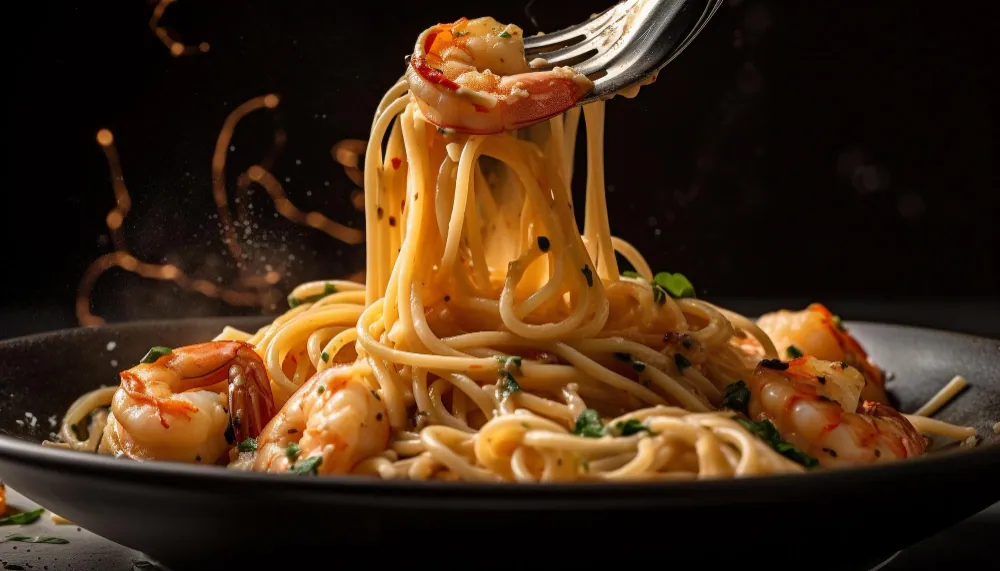

Variations
- For a marinara-style sauce, add more diced tomatoes or tomato paste during the cooking process.
- Customize the acid level by adding splashes of white wine or white wine vinegar for brighter tomato taste.
- Stir in some crushed red pepper flakes or sprinkle of cayenne or your favorite hot sauce to make it spicy.
- Zing it up with a squeeze of lemon juice and grate of lemon zest for citrus notes.
- Fold in chopped fresh parsley towards the end as a flavorful garnish.
- Adjust the ratio of liquids and thickness to taste – add more cream to pale the color or thin it out with extra milk.
- Letting the sauce simmer longer allows the flavors to marry and deepens the flavor profile.
Experiment with these tweaks to put your own spin on the basic pink pasta sauce recipe to create the perfect customized pasta night every time.
Storage And Freezing
Storing and freezing leftover homemade pink pasta sauce is simple. For refrigerated storage of up to 5 days, transfer any extra sauce to an airtight container. This will keep the sauce fresh in the fridge. If you have more sauce than you’ll use within a week, freezing is the best option for long-term storage. Portion the sauce into smaller, freezer safe bags or containers and seal them tightly to prevent freezer burn. Frozen pink sauce can be kept in the freezer for months.
When ready to eat, thaw the sauce either overnight in the fridge or slowly on the stove top until it reaches your desired consistency once again. You can also freeze the sauce in individual portions, which is convenient for thawing just what you need within a few months. Following these steps allows the delicious homemade pink pasta sauce to be enjoyed well past the day it’s made. Simply store or freeze extra batches so it’s ready when a craving for pasta strikes!
Why Add Pasta Water To Sauce?
It’s a common practice when making Italian dishes to reserve some of the starchy liquid from boiling the pasta, but many home cooks don’t know why Italians do this. The water the pasta was cooked in contains starches released from the noodles. By adding a ladle or two of this pasta water to your sauce, it creates a slurry that helps the sauce emulsify and thicken. The starches in the water act as a thickening agent, allowing the sauce to better bond with the pasta.
This results in a creamy, rather than oily or broken sauce. It’s an important tradition in Italian cooking that takes your sauce to the next level. So the next time you cook pasta, be sure to reserve about 1⁄2 cup of the cooking water by setting it aside in a small measuring cup or glass to use in your sauce for ultimate flavor.
Pasta Water Substitutes
Here are some alternatives to using pasta water when making the pink pasta sauce:
- If not reserving cooking liquid, substitute 1-2 Tbsp of hot water for every ladle of pasta water called for.
- Dissolve 1⁄2 tsp cornstarch or arrowroot starch in a tablespoon of cold water, then stir into sauce to act as thickener in place of pasta starches.
- Use the cooking liquid from simmered vegetables like mushrooms, zucchini or tomatoes as a substitution.
- Substitute 1 Tbsp dry wine or extra cream/milk per ladle of pasta water called for in sauce.
- Add a tablespoon of your favorite broth like chicken or vegetable in place of pasta water for deeper flavor.
While pasta water is ideal for its signature starch content, these options provide suitable thickness or moisture in a pinch when you haven’t reserved starchy pasta cooking liquid. Feel free to experiment with different liquids to suit your sauce.
Is Rosa Sauce The Same As Vodka Sauce?
| Pink Sauce (Rosa Sauce) | Vodka Sauce |
| Made with tomato sauce, heavy cream, and grated cheese to add a rich and creamy element. | Features tomato sauce as the base but derives its flavor from the addition of vodka as a primary ingredient. |
| Provides a lighter, pink-hued tomato sauce. | Takes on a darker red color from the vodka. |
| Focused on tomato and dairy flavors. | Has a characteristic alcoholic bite from the vodka. |
| Not an alcoholic sauce. | Contains vodka, making it an alcoholic pasta sauce. |
| Main difference is lack of vodka as a key ingredient. | Pink sauce does not contain vodka as a distinguishing characteristic. |
In summary, while both sauces use tomato sauce as a base, pink sauce derives its creamy texture and light pink color from dairy additions like heavy cream and cheese, versus vodka sauce employing vodka as the signature flavoring ingredient that sets it apart.
Can I Use Milk Instead Of Cream In Pasta Sauce?
While it is possible to substitute milk for heavy cream in pasta sauce, there are a few things to keep in mind. Milk has less fat than cream, so the sauce may not have the same luscious, velvety creaminess when using milk instead. For the best texture, whole milk is recommended over skim or low-fat varieties, which will make the sauce thinner. The sauce may also need a thickener like cornstarch to prevent separating.
As milk is more acidic than cream, it is more prone to curdling when mixed with the tomatoes in pasta sauce. To avoid curdling, add any acidic ingredients like lemon juice or wine very gradually and do not let the sauce boil once these are added – gently simmer instead. Simmering the pasta sauce until slightly thickened also helps prevent curdling when using milk rather than cream. While milk can work in a pinch, heavy cream will provide a smoother, richer pasta sauce. Taking precautions like gradual acid addition and gentle simmering helps avoid issues when substituting milk for cream.
Can You Add Milk To Tomato Sauce Without Curdling?
There are some tricks to adding milk to tomato sauce without risk of curdling. As tomatoes are naturally acidic, it’s best to first simmer any tomato sauce before enriching it with dairy. This helps cook off some of the acidity. It also helps to add a small amount of fat like butter or cream cheese to the sauce beforehand, as the fat coats the protein molecules and reduces curdling. When adding the milk, whisk it in gradually while the sauce is off the heat instead of all at once to gently combine it without boiling.
A pinch of baking soda can also help neutralize the acid in the tomatoes further. Opting for whole milk over lower fat varieties further decreases the chances of curdling, as its higher butterfat content provides a protective layer. Continuing to simmer the creamy tomato sauce mixture after incorporating the milk allows the flavors to fully develop into a smooth finished product. Following these steps makes it possible to safely add milk to tomato sauce for a richer variation without risk of separation.
Helpful Tips
- For serving, finely grate Parmesan cheese using a block rather than pre-shredded bag. Finely grated melts better.
- Taste and adjust seasonings throughout the cooking process – it should taste bold enough to stand up to the rich cream.
- Simmer the sauce longer to allow the flavors to marry and the tomatoes to fully cook down.
- If the sauce seems thin, simmer uncovered to thicken as it reduces.
- For cream sauces that may separate, temper a bit of the hot sauce into cold cream before whisking back in.
- Let the cooked dish cool slightly before serving, as the heat can intensify flavors too much straight out of the pot.
- Feel free to experiment with roasted or sautéed veggies mixed into the sauce for extra texture and nutrition.
Proper seasoning and a gentle hand are keys to achieving the perfect texture and balance of flavors in pink pasta sauce.
Conclusion
Pink sauce derives its light color and luxurious texture from cream and cheese added to traditional tomato sauce. With a foundational understanding of ingredients and properties, readers now have a solid starting point for putting their own spin on classic pasta sauces.
Frequently Asked Questions
What is pink pasta sauce made of?
Pink pasta sauce gets its light rosy hue and rich texture from a combination of tomatoes, cream or milk, and cheese like Parmesan or ricotta.
What is pink sauce actually called?
While often called “pink sauce”, it can also go by names like vodka sauce, rosé sauce or cream sauce depending on specific recipes and regions.
Can you buy pink pasta sauce?
While some grocery stores may carry jarred versions, pink sauce is best enjoyed when made from scratch at home to ensure quality of ingredients and flavor.
What does pink sauce actually taste like?
Rich yet mildly acidic, pink sauce balances the brightness of tomatoes with indulgent creaminess and savory nutty notes from cheeses like Parmesan.
Why Is It Called Pink Sauce?
The light blush hue it takes on from its namesake ingredients is why this treasured pasta topping became known as “pink sauce.”
What is Italian pink sauce made from?
Traditional Italian pink sauce is made from sun-dried tomatoes, olive oil, garlic, heavy cream or mascarpone cheese, and herbs like basil for flavor.
What is an Italian pink sauce recipe?
A classic recipe combines diced tomatoes, diced sun-dried tomatoes, heavy cream, minced garlic, shredded basil and parmesan cheese. It’s simmered until thickened into a luxurious pink-hued sauce.
What is another name for pink sauce?
Depending on regional variations and ingredients, pink sauce is also sometimes called rosa sauce.
Pink Sauce For Pasta
Course: Pasta SaucesCuisine: American4
servings5
minutes15
minutes654
kcal20
minutesIndulge in a culinary masterpiece with our Pink Sauce for Pasta recipe. This creamy and flavorful concoction combines the richness of tomato sauce with the velvety smoothness of cream, resulting in a delectable symphony of flavors. Infused with garlic, herbs, and a hint of chili flakes for a subtle kick, this sauce elevates any pasta dish.
Ingredients
1 tablespoon olive oil
1/2 white onion chopped
15 ounces plain tomato sauce
1 tablespoon fresh basil roughly chopped
1 teaspoon chicken bouillon powder one cube
1 tablespoons sugar
1 teaspoon coarse kosher salt
1 cup half & half
1 tablespoons parmesan cheese finely grated
1 cup reserved pasta water wine or tap water
4 garlic cloves chopped
Directions
- Dice onion and mince garlic. Roughly chop fresh basil leaves. Grate Parmesan cheese. In a measuring cup, prepare heavy cream. Have on hand: jarred tomato sauce, chicken bouillon, sugar and salt.
- In a saucepan, heat olive oil over medium heat. Add onions and sauté for 4-5 minutes until translucent. Add garlic and sauté 1 minute more.
- Add tomato sauce, bouillon, sugar and salt to onions. Stir to combine. Bring to a low simmer and cook for 5-7 minutes to blend flavors.
- Remove from heat briefly. Use an immersion blender to puree the sauce directly in the pan, leaving some texture from the basil.
- Return pan to low heat. Stir in heavy cream and Parmesan until melted and blended. Taste and adjust seasoning as needed. Toss with cooked pasta and serve warm, garnished with more basil. Enjoy!
Notes
- Pasta: any bite-size pasta will work, like penne, farfalle or fusilli
- Cheese: Use high-quality fresh parmesan (not pre-shredded). Grate it, and allow it to come to room temperature so it will melt really smoothly.
- Make Ahead Instructions: Make the sauce ahead of time, but store the sauce and cooked pasta separately in the fridge. Add the sauce to a saucepan to rewarm and then stir in the pasta.
- Protein: You can add cooked chicken, shrimp, or tofu if you’d like.

